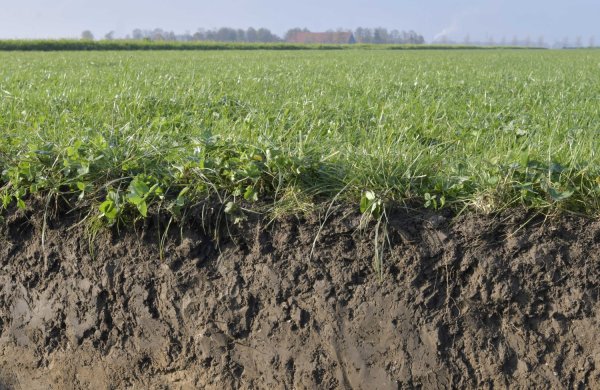
Longread
Is something up with soil?
Over the past few years there’s been more and more discussion among farmers, advisers, government agencies, funders and the media about agricultural soil, and soils in general. This is a positive development. Agricultural land is the foundation of food production and also fulfils several other important functions, such as water buffering, carbon sequestration and strengthening biodiversity. But some reports seem to suggest there’s something fundamentally wrong with our agricultural land. What’s the real story? What do we know about our soils?
The good news
Let’s start with the good news: the Netherlands has excellent agricultural land, certainly when compared to agricultural soils in other parts of Europe or the rest of the world. Our soils are highly fertile, we have good water management, and the land is level (apart from in South Limburg). All of this means there’s hardly any marginal or unproductive land in the Netherlands. To some extent, this has come about naturally: in river deltas along the coast, fertile clay gets deposited by the rivers and the sea, and in wet conditions this leads to peat formation. But there’s certainly a significant element of human influence too: thanks to the creation of agricultural plots, water management, and years (or even centuries) of fertiliser application, soil quality has improved so much that high-yielding crops can be grown everywhere. If we just consider the productivity function of agricultural land it’s difficult to conclude that we have a problem. Compared to international standards, crop yields are very high, and are still improving for many crops. Of course, other factors come into play here too, such as the development of increasingly high-yielding crop varieties, but such good results wouldn’t be possible if you don’t have good soils to start with.
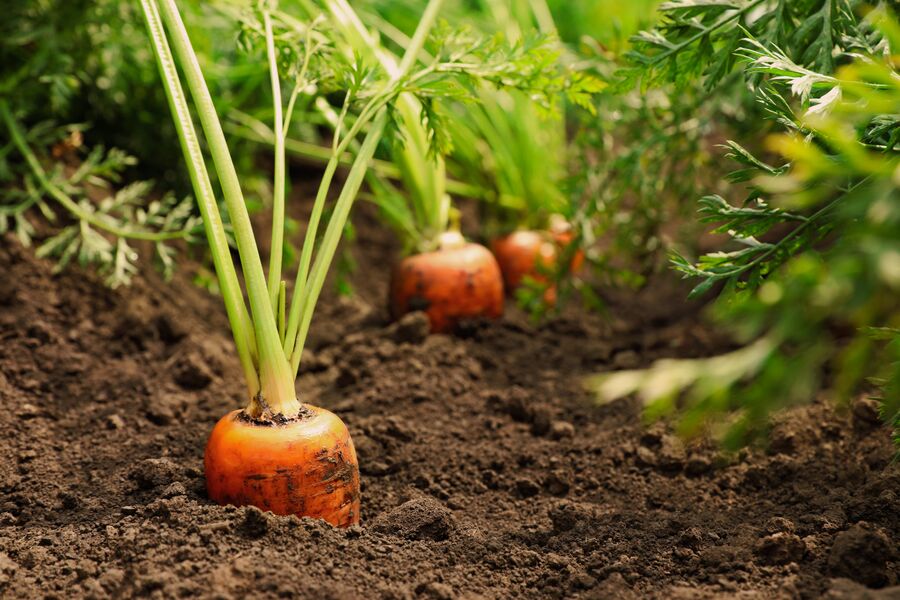
Good soil quality cannot be taken for granted
We can’t take good soil quality for granted. The current quality of our agricultural soils is the result of a combination of natural factors such as soil variety and the depth of the groundwater, as well as human interventions such as fertilisation, ploughing and liming. Because the harvesting of crops removes nutrients, and natural processes break down carbon and acidify the soil, it’s important to restore and maintain balance in the soil. This balance relates not just to carbon, nitrogen or phosphate, but also to the necessary soil structure and the organisms that live in the soil. By nature, soils are not an infinite source of water and nutrients, and agricultural soils therefore need to be managed. This management is the only way to ensure that soils can deliver nutrients, there’s enough water available, and that crops can establish deep roots unhindered. Soil management also ensures that soil life can thrive, and this helps to decompact the soil, release nutrients and prevent pathogenic organisms from taking hold. Maintaining the productivity of agricultural soils requires a smart combination of fertilisation, crop planning, drainage and tillage.
So as long as our agricultural soils are fertile, does that mean we don’t need to be concerned about the quality of the soil? No – there is real cause for concern. Today, the worries are about how intensively soils are being used, the growing pressure for land to be used for purposes other than agriculture, and a greater dependency on natural processes beyond our control. We should note that although many people use the terms “sustainable soil management” and “healthy and vital soil”, it’s still not very straightforward to define soil quality. Notions of quality are highly dependent on user objectives: the soil we might want for environmental objectives is not the same as we might want for agricultural objectives.
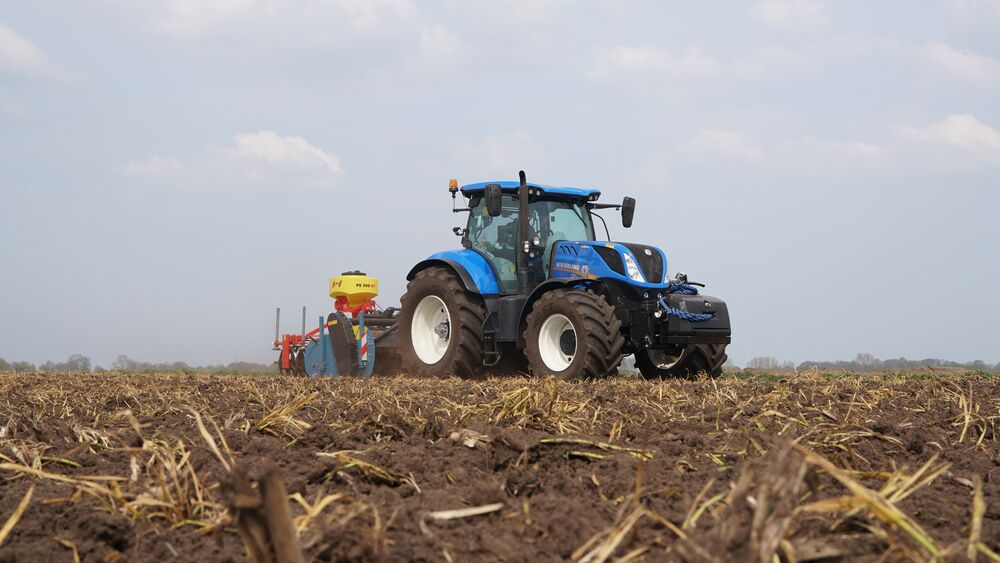
The intensity of soil use
Intensive soil use – with a high proportion of cash crops, intensive tillage and a relatively low level of organic matter – along with careless soil management can in many cases lead to less than optimal soil quality. Poor soil quality might manifest itself as soil compaction, soil-borne pests and diseases, and pH levels being too low. This will lead not only to a decline in yields and possible problems with crop quality, but also to negative impacts on the quality of the local environment. These impacts can include eutrophication of ground and surface water, declining water retention in the soil, and higher greenhouse gas emissions.
One important underlying cause of intensive soil use is the high economic value of land. The Netherlands happens to have the most expensive agricultural land in the world. That’s because we use the land in our fertile delta not just for agriculture but for many other things too, making agricultural land relatively scarce. With a hectare of land being so expensive, it needs to be intensively used to make it economically viable. So our land use keeps growing more intensive. In the land-based livestock sector that means producing more milk per hectare, by maximising roughage production on the farm and relying more on bought livestock feed. In the arable farming sector, producers are shifting towards more profitable crops such as potatoes, onions and flower bulbs, rather than crops with lower profit margins such as grains. The intensity of land use associated with many cash crops poses a risk to the quality of agricultural land.
In the Netherlands, it’s not just land that is scarce, so is labour. This means that farmers will want to minimise the amount of labour they use in their business. In the horticulture and livestock sectors, this is evident in the use of automation (robots for picking, milking and feeding), while the arable farming sector continues to increase the size and capacity of its machinery. These larger machines pose a threat to soil quality because they’re heavy and are used to harvest crops in less than optimal soil conditions.
The challenges
What problems are farmers having with their soils? Here are some examples.
- Soil structure and soil compaction. Heavy machinery operating on the land in wet conditions causes soil compaction. Not just at the surface, but often deeper down too. Deep soil compaction is difficult to solve, apart from in heavy clay soils where drought and frost create fairly deep fractures. Soil compaction impedes root growth and the absorption of water through capillary action, which means crops quickly suffer in dry conditions. At the same time, the soil also struggles to absorb water properly. This leads to crops getting damaged during heavy rainfall, and it becomes difficult to operate machinery on the land. If farmers do bring machinery onto the land, it just exacerbates the damage. Climate change is only worsening the impacts of soil compaction. Other problems related to soil structure are evident in soils prone to slaking (loamy and light clay soils) or wind erosion (peat subsoils).
- Drought. Agricultural soils are drained to allow crops to fully take root. This is because plant roots don’t like having too much water and will die if they are submerged for any length of time. Maintaining a relatively low water level during the growing season in particular means that crops also struggle to access water during drought. Climate change is increasing the frequency of summer droughts, and water shortages then lead to irrigation bans. The impact is magnified by the fact that growing catch crops and green manure crops – practices that benefit the level of organic matter in the soil, and groundwater quality – also exacerbates evaporation. Drought also often leads to lower yields, making fertiliser use less effective and increasing the likelihood of post-harvest nutrient losses.
- Soil-borne diseases. Soil is not dead matter: on the contrary, it is home to a multitude of organisms, most of them invisible to the naked eye. Many of these organisms perform useful functions, for example by making nutrients available to plants. However, some organisms can be very damaging to crops. If such an organism happens to be present in a particular plot and crops vulnerable to that organism are then grown there, the organism will rapidly multiply. If the same crop is grown there again within a year or two, the damage will be even greater. In other words: a one-dimensional, intensive crop plan with just a few crops planted on large plots will lead to an accumulation of harmful soil organisms (fungi, bacteria, insects, nematodes). Lighter clay and loamy soils, as well as sandy soils, are all more prone to this.
- Soil fertility in arable farming and horticulture. Land is used so intensively now – particularly in arable farming – that it’s become challenging to apply enough organic matter within the parameters of current legislation and regulations. Intensive tillage for cash crops leads to organic matter being broken down at relatively high levels. At the same time, these crops tend to leave little behind in the way of crop residues, and current legislation and regulations limit how much organic fertiliser can be applied. In that sense it’s understandable that farmers are calling for some relaxation of fertiliser standards, so that they can apply more organic matter. At the same time, the reason these standards are there in the first place is to prevent emissions and to protect groundwater and surface water quality. So it’s a topsy-turvy perspective, because the problem is the intensive crop plan, not the fertiliser standards. In short, while there’s an economic incentive to use land even more intensively, fertiliser standards make it impossible to do so. Agriculture is therefore reaching the limits of what it can do.
- Soil fertility in dairy farming. Declining soil fertility is a topic of debate in the dairy farming sector, although dairy farms tend to have higher average levels of soil fertility than arable farms. However, soil fertility is often a problem for dairy farmers with plots where maize has been grown year after year, with little organic fertiliser being used. But dairy farmers tend to be concerned about their grasslands, where phosphate levels are declining. Is that a problem? Not if you look at the often huge supply of phosphate that has been built up over time, and the minimum quantity required for the production of sufficient, healthy roughage. Lower phosphate levels in roughage are however something to consider in terms of the health of highly productive animals. Phosphate levels in manure are also declining as a result. If nitrogen standards limit the use of manure on a farm, phosphate fertilisation will decline as phosphate levels in manure decline. Farms that participate in derogation will not be able to fix that by using artificial phosphate fertiliser.
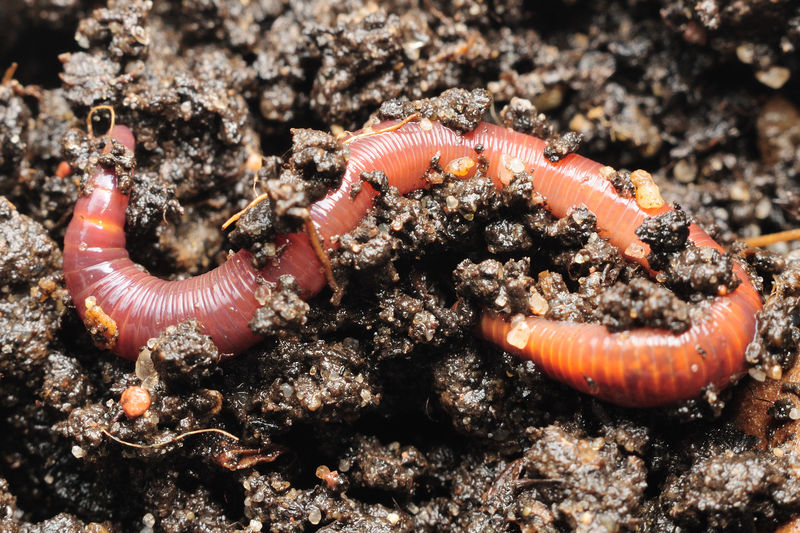
Importance of soil life
Soil life is the biological engine driving all sorts of processes which actively contribute to improvements in the soil structure and the availability of nutrients. No agricultural system can possibly exist without soil life. Fungi and soil fauna create a structure for soil particles. They make it nicely homogenous, and they make nutrients available to crops. They also perform carbon sequestration in the soil, increasing its buffering capacity. Diversity in soil life (with lots of different species) also reduces the risk of pests and diseases. Soil is actively influenced by all the life within it, but the volume and diversity of that soil life is also partly determined by the type of soil, the weather, the groundwater depth, the fertiliser applied and the crop plan. Under the right circumstances, almost any soil can become home to a healthy and diverse population of fauna and flora. In the west of the Netherlands, for example, experience has shown that many meadow birds prefer recently fertilised grasslands (with lots of earthworms and soil life) to nature conservation sites where there’s much less food available.
At the same time, soil life is not by definition beneficial to agriculture: some organisms can be immensely damaging to crops. Certain soil fungi, insects and nematodes attack crops under the ground or sometimes on the surface, causing problems to crop growth and sometimes to product quality. The cultivation of certain crops or crop varieties that are prone to attack can then lead to a rapid growth of the population of these harmful organisms, which then means that if another similarly vulnerable crop is grown in the same place the following year, the damage will be even greater. This problem can be managed if we’re aware of the presence of harmful organisms in specific plots and select crops and varieties accordingly. The damage is often worse though if the growing conditions for a crop turn out to be less than optimal, as a result of too much or too little water, for example. That’s why good soil quality, particularly in terms of water management and soil structure, can indirectly influence the damage caused to crops by harmful soil organisms.
There’s a whole range of interventions available to encourage beneficial soil life: in essence, it’s about creating the right conditions when it comes to nutrients, oxygen and water. For nutrients it’s all about crops, crop residues and green manure crops, but also the application of organic fertiliser. If you want to ensure there’s enough oxygen in the soil, it’s important to create a loose structure and to avoid the ground being waterlogged. That said, water is an important factor in creating healthy, active soil life. It’s about striking the right balance: not too much, and not too little.
The power of data
An understanding of soil quality is always based on practical experience and measurements. The Netherlands gathers huge amounts of data on its soil quality. Data on more than 50 chemical, physical and biological properties is available for almost every plot. Simple soil test pits can also reveal a lot about soil structure and root systems. These measurements can shed light on the key challenges for each individual plot. Certain basic soil properties are well established as the key metrics for the various functions that soil performs. These include the level of organic matter, texture, pH and nutrient supplies. For nutrients, pH and organic matter, target levels and ‘good agricultural practices’ have also been defined. However, it’s important that we continue to build on our knowledge of the biological and physical aspects of soil quality, how these can be measured, and what the target levels are. Wageningen University & Research recently defined a list of measurements as a way of furthering our understanding not just of soil fertility but also of the other services provided by soil. And in 2019, university and research institutes and soil advisers in the Netherlands compiled their knowledge of soil quality measurement in the Open Soil Index. However, farmers aren’t making much use of this information yet: soil analyses are mostly performed for the purpose of assessing how much fertiliser to apply. There are many untapped opportunities here for tackling the problems discussed above in a targeted way through the use of appropriate crop plans, fertilisation practices tailored to the fertility of the soil, and using the right machines at the right time.
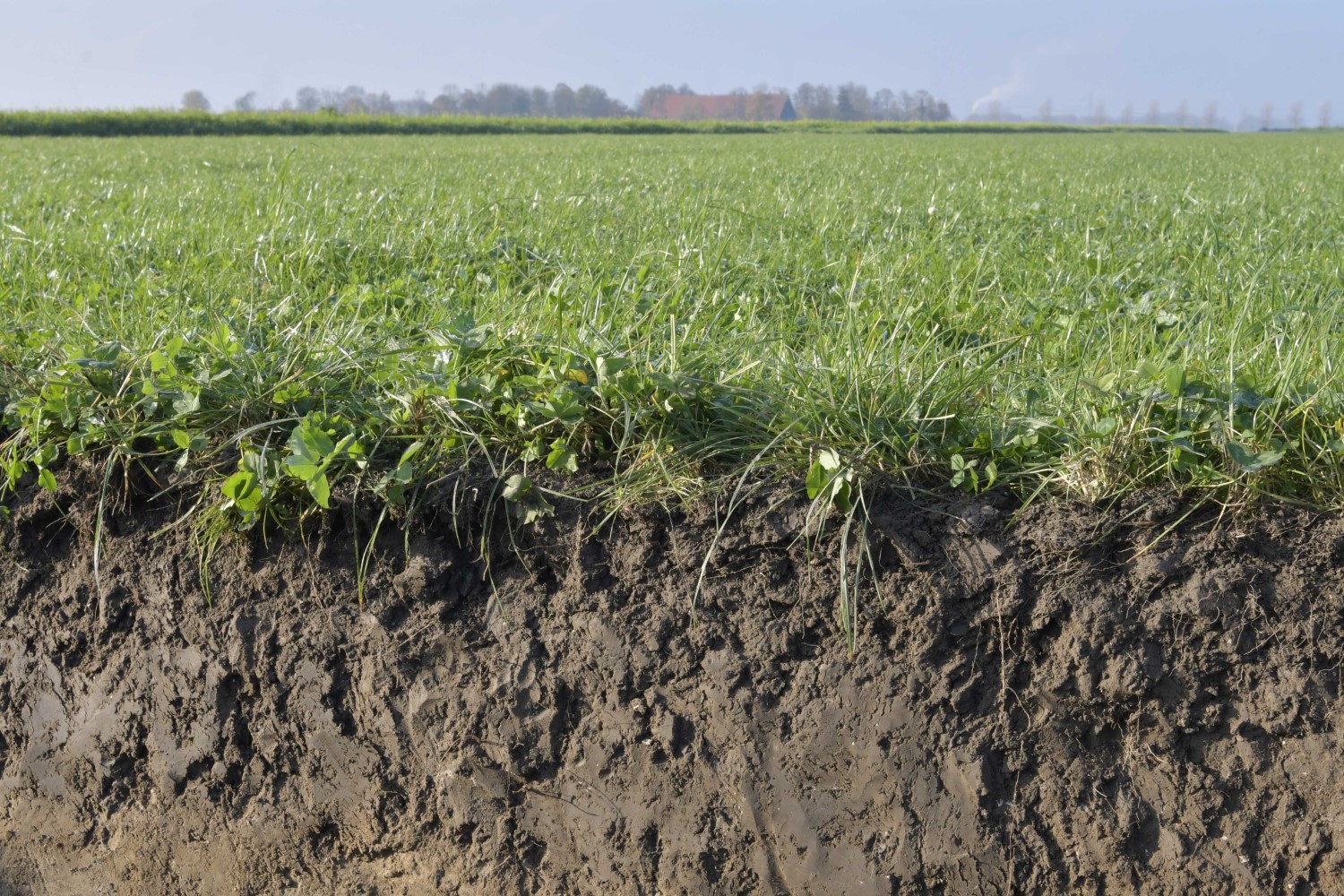
Common misconceptions
The complication from a scientific perspective is the prevalence of easy soundbites about soil life and healthy soils, which all sound too good to be true. These simplistic claims also fail to do justice to the complexity of agro-ecosystems, because they reduce the reality of the situation to a few simple, black and white choices. Here are some examples:
- You have to feed the soil, not the plant. There isn’t a single soil-based system in agriculture in which only the plant is fed. This can only be done in water-based greenhouse horticulture or when using an inert substrate, rather than soil-based cultivation. Even if you only used artificial fertiliser, crops and green manure crops will produce organic material, which provides nutrients to soil life. In fact, even in fairly intensive arable farming systems, crops and green manure crops account for half of the total supply of organic matter. Plants also absorb nitrogen directly from organic fertilisers, so it’s always a combination of feeding the soil and the plant.
- If the soil is healthy, the crop will also be healthy. The relationship between soils and crop health seems clear: soil has a major influence on growing conditions for crops. Under less than optimal growing conditions, crops will also be less resilient to pests and diseases. This is particularly true for certain pests and diseases known as opportunistic pathogens, which tend to attack weak plants. However, aggressive fungi such as phytophthora infestans (potato blight) and downy mildew in onions aren’t easily deterred by our notions of crop resilience and soil health. The idea that crops won’t get sick in top-quality soil fails to sufficiently take account of the wide variety of conditions that field crops are subjected to. Extreme precipitation, drought and wild temperature fluctuations will always have an effect on crops, however great the soil might be. Crops will therefore always be prone to pests and diseases.
- Good soil life consists of aerobic organisms. It’s true that you don’t want low levels of oxygen in soil, because this would kill off many soil organisms and generate substantial gaseous emissions. But it would be wrong to think that the use of fertilisers derived from an anaerobic process are harmful to the soil. Because whenever you distribute an anaerobic fertiliser like slurry or bokashi to your land, oxygen gets added. The anaerobic organisms in the fertiliser then die and the organic matter is broken down by the soil life. Which is just as well, because otherwise slurry and bokashi would be rather poor fertilisers: the nutrients only become available to the crop after this breakdown has taken place. However, large quantities of slurry (35m3 or more per hectare in a single application) can in fact temporarily create a low-oxygen environment. It’s difficult to say exactly how harmful that is. When soil bioremediation is performed (through flooding or applying an airtight ground cover for several months), soil life has been seen to quickly recover.
- Artificial fertiliser and crop protection agents are bad for soil life, so organic agriculture is better. It sounds reasonable: crop protection agents are used to combat pests, diseases and weeds, so they must also kill soil organisms. People make similar associations with artificial fertiliser: it’s chemical, so it’s unhealthy, and therefore harmful. But this is too simplistic. The first problem with this reasoning is that ‘everything is chemical’ and so the harmfulness of a substance has nothing to do with whether it’s natural or synthetic in origin. Lots of poisonous substances exist in nature. They’re often produced by organisms as a defence mechanism, and these substances are used in organic agriculture too. Furthermore, all crop protection agents are tested for any harmful effects they might have on soil life. These agents are often highly selective (certainly when compared to natural poisons). They’re designed to specifically target a particular harmful organism. So they’ll target aphids, but not ladybirds and green lacewings. It’s true that artificial fertilisers aren’t subject to the same certification procedure, but they are subject to a different ‘safety argument’: there’s a legal requirement to use only as much as is needed to encourage plant growth. Recently, Ros and de Vries showed that even a sustainable circular agricultural system needs artificial fertiliser and that when it’s applied correctly, it actually delivers added value to the local living environment because it reduces both run-off and ammonia emissions, and improves the soil.
- Useful soil life doesn’t occur naturally in soil, and has to be added. This notion is certainly used to justify the marketing of all sorts of products, but the evidence is dubious. A variety of system trials have shown that these products have negligible effects. Soil organisms require specific conditions: fungi thrive in undisturbed or minimally disturbed soils containing organic matter that’s relatively slow to digest. Bacteria on the other hand thrive on easily digestible organic matter and are less bothered by tillage. So if there’s a change in soil management and organic matter strategy, there will also be a change in soil life composition. Soil life can often be present but inactive because the right conditions aren’t in place. Therefore, soil life is largely an outcome of soil management. So, if you’re working with intensively tilled soil and applying lots of fresh organic matter, it would be pointless to add soil fungi, for example. If you wanted to encourage soil fungi (which itself raises questions), you would be better off reducing tillage and applying less easily digestible organic matter.
Conclusion
It’s good that there’s such widespread interest in soils, because soils perform important functions for agriculture and the environment as a whole. There’s no reason to panic about the quality of agricultural land in the Netherlands, because we still have very good, fertile agricultural land. There are some challenges, including some specific agricultural ones such as soil compaction, and these are drivers of increasingly serious risks when combined with the effects of climate change.
New objectives keep emerging for our use of agricultural land, such as water storage or carbon sequestration, and these don’t always align with agricultural objectives. It’s important to set realistic expectations and to make choices where necessary. We can’t do everything everywhere. We also need to be vigilant about the tendency to simplify problems and solutions. Simplifications fail to address the reality of the situation and can lead to one-sided or even nonsensical interventions.